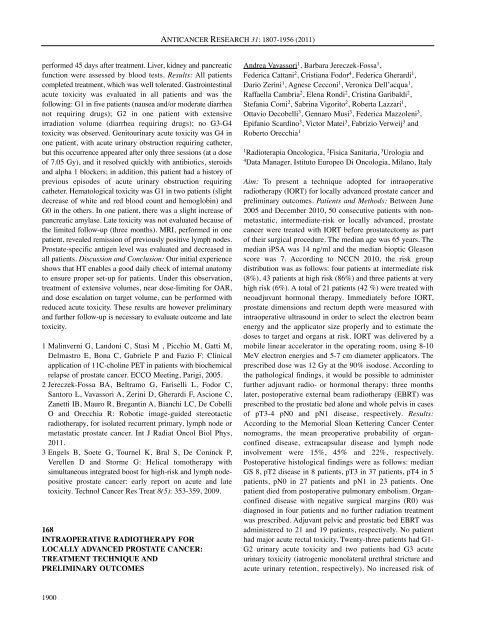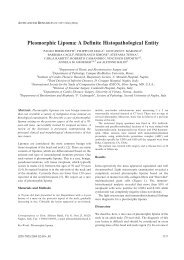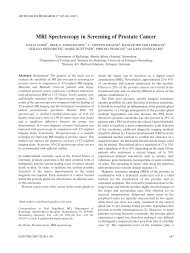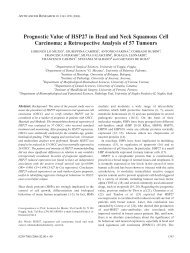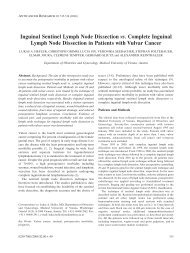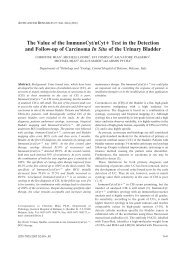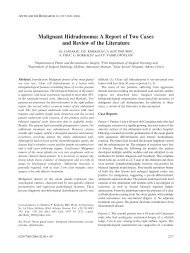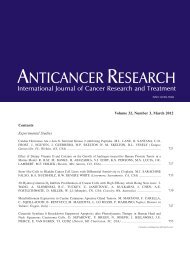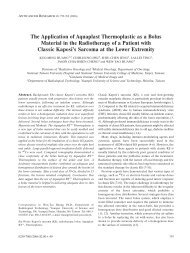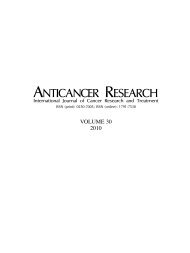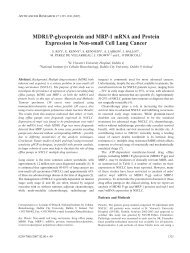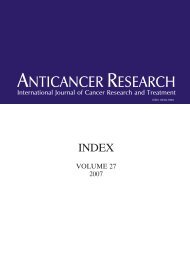ABSTRACTS OF THE 21st ANNUAL MEETING OF THE ITALIAN ...
ABSTRACTS OF THE 21st ANNUAL MEETING OF THE ITALIAN ...
ABSTRACTS OF THE 21st ANNUAL MEETING OF THE ITALIAN ...
You also want an ePaper? Increase the reach of your titles
YUMPU automatically turns print PDFs into web optimized ePapers that Google loves.
performed 45 days after treatment. Liver, kidney and pancreatic<br />
function were assessed by blood tests. Results: All patients<br />
completed treatment, which was well tolerated. Gastrointestinal<br />
acute toxicity was evaluated in all patients and was the<br />
following: G1 in five patients (nausea and/or moderate diarrhea<br />
not requiring drugs); G2 in one patient with extensive<br />
irradiation volume (diarrhea requiring drugs); no G3-G4<br />
toxicity was observed. Genitourinary acute toxicity was G4 in<br />
one patient, with acute urinary obstruction requiring catheter,<br />
but this occurrence appeared after only three sessions (at a dose<br />
of 7.05 Gy), and it resolved quickly with antibiotics, steroids<br />
and alpha 1 blockers; in addition, this patient had a history of<br />
previous episodes of acute urinary obstruction requiring<br />
catheter. Hematological toxicity was G1 in two patients (slight<br />
decrease of white and red blood count and hemoglobin) and<br />
G0 in the others. In one patient, there was a slight increase of<br />
pancreatic amylase. Late toxicity was not evaluated because of<br />
the limited follow-up (three months). MRI, performed in one<br />
patient, revealed remission of previously positive lymph nodes.<br />
Prostate-specific antigen level was evaluated and decreased in<br />
all patients. Discussion and Conclusion: Our initial experience<br />
shows that HT enables a good daily check of internal anatomy<br />
to ensure proper set-up for patients. Under this observation,<br />
treatment of extensive volumes, near dose-limiting for OAR,<br />
and dose escalation on target volume, can be performed with<br />
reduced acute toxicity. These results are however preliminary<br />
and further follow-up is necessary to evaluate outcome and late<br />
toxicity.<br />
1 Malinverni G, Landoni C, Stasi M , Picchio M, Gatti M,<br />
Delmastro E, Bona C, Gabriele P and Fazio F: Clinical<br />
application of 11C-choline PET in patients with biochemical<br />
relapse of prostate cancer. ECCO Meeting, Parigi, 2005.<br />
2 Jereczek-Fossa BA, Beltramo G, Fariselli L, Fodor C,<br />
Santoro L, Vavassori A, Zerini D, Gherardi F, Ascione C,<br />
Zanetti IB, Mauro R, Bregantin A, Bianchi LC, De Cobelli<br />
O and Orecchia R: Robotic image-guided stereotactic<br />
radiotherapy, for isolated recurrent primary, lymph node or<br />
metastatic prostate cancer. Int J Radiat Oncol Biol Phys,<br />
2011.<br />
3 Engels B, Soete G, Tournel K, Bral S, De Coninck P,<br />
Verellen D and Storme G: Helical tomotherapy with<br />
simultaneous integrated boost for high-risk and lymph nodepositive<br />
prostate cancer: early report on acute and late<br />
toxicity. Technol Cancer Res Treat 8(5): 353-359, 2009.<br />
168<br />
INTRAOPERATIVE RADIO<strong>THE</strong>RAPY FOR<br />
LOCALLY ADVANCED PROSTATE CANCER:<br />
TREATMENT TECHNIQUE AND<br />
PRELIMINARY OUTCOMES<br />
1900<br />
ANTICANCER RESEARCH 31: 1807-1956 (2011)<br />
Andrea Vavassori 1 , Barbara Jereczek-Fossa 1 ,<br />
Federica Cattani 2 , Cristiana Fodor 4 , Federica Gherardi 1 ,<br />
Dario Zerini 1 , Agnese Cecconi 1 , Veronica Dell’acqua 1 ,<br />
Raffaella Cambria 2 , Elena Rondi 2 , Cristina Garibaldi 2 ,<br />
Stefania Comi 2 , Sabrina Vigorito 2 , Roberta Lazzari 1 ,<br />
Ottavio Decobelli 3 , Gennaro Musi 3 , Federica Mazzoleni 3 ,<br />
Epifanio Scardino 3 , Victor Matei 3 , Fabrizio Verweij 3 and<br />
Roberto Orecchia 1<br />
1 Radioterapia Oncologica, 2 Fisica Sanitaria, 3 Urologia and<br />
4 Data Manager, Istituto Europeo Di Oncologia, Milano, Italy<br />
Aim: To present a technique adopted for intraoperative<br />
radiotherapy (IORT) for locally advanced prostate cancer and<br />
preliminary outcomes. Patients and Methods: Between June<br />
2005 and December 2010, 50 consecutive patients with nonmetastatic,<br />
intermediate-risk or locally advanced, prostate<br />
cancer were treated with IORT before prostatectomy as part<br />
of their surgical procedure. The median age was 65 years. The<br />
median iPSA was 14 ng/ml and the median bioptic Gleason<br />
score was 7. According to NCCN 2010, the risk group<br />
distribution was as follows: four patients at intermediate risk<br />
(8%), 43 patients at high risk (86%) and three patients at very<br />
high risk (6%). A total of 21 patients (42 %) were treated with<br />
neoadjuvant hormonal therapy. Immediately before IORT,<br />
prostate dimensions and rectum depth were measured with<br />
intraoperative ultrasound in order to select the electron beam<br />
energy and the applicator size properly and to estimate the<br />
doses to target and organs at risk. IORT was delivered by a<br />
mobile linear accelerator in the operating room, using 8-10<br />
MeV electron energies and 5-7 cm diameter applicators. The<br />
prescribed dose was 12 Gy at the 90% isodose. According to<br />
the pathological findings, it would be possible to administer<br />
further adjuvant radio- or hormonal therapy: three months<br />
later, postoperative external beam radiotherapy (EBRT) was<br />
prescribed to the prostatic bed alone and whole pelvis in cases<br />
of pT3-4 pN0 and pN1 disease, respectively. Results:<br />
According to the Memorial Sloan Kettering Cancer Center<br />
nomograms, the mean preoperative probability of organconfined<br />
disease, extracapsular disease and lymph node<br />
involvement were 15%, 45% and 22%, respectively.<br />
Postoperative histological findings were as follows: median<br />
GS 8, pT2 disease in 8 patients, pT3 in 37 patients, pT4 in 5<br />
patients, pN0 in 27 patients and pN1 in 23 patients. One<br />
patient died from postoperative pulmonary embolism. Organconfined<br />
disease with negative surgical margins (R0) was<br />
diagnosed in four patients and no further radiation treatment<br />
was prescribed. Adjuvant pelvic and prostatic bed EBRT was<br />
administered to 21 and 19 patients, respectively. No patient<br />
had major acute rectal toxicity. Twenty-three patients had G1-<br />
G2 urinary acute toxicity and two patients had G3 acute<br />
urinary toxicity (iatrogenic monolateral urethral stricture and<br />
acute urinary retention, respectively). No increased risk of


